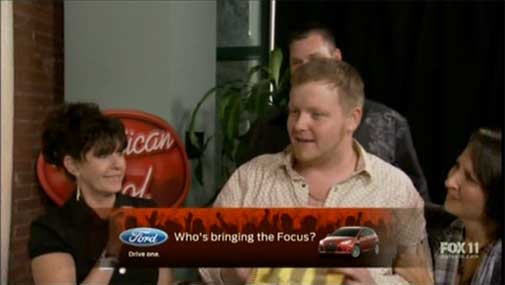
Your move: You don't want to watch ads on broadcast TV shows, so you record the shows to watch later, and zip through the commercials. Network countermove: Inject more giant type and bold graphics into the ads, so you can read (and get) the message even as you fast-forward. But now, the networks have gotten even more insidious, and are stuffing ads where you CAN'T miss them: in the programs.
Product placement is as old as television, of course. But the lengths to which the networks are sinking -- well, come to think of it, those are as old as television, too. Take two very recent, very repugnant examples...
On American Idol last Thursday, Fox slapped a horizontal banner ad right on top of the program itself -- a big, inescapable, intrusive promo for the Ford Focus, showing the Ford logo, a picture of the automobile itself, and the slogan, "Who's bringing the focus?"
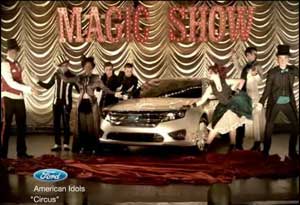
For years, American Idol has featured contestants in Ford "music videos," which is a horrible enough bit of internal advertising. But this is something new: just slapping ad copy on top of the program image itself, like a "Fragile" stamp on a package.
In the case of the Ford Focus internal ad, it ran for 10 full seconds, on top of shots of the American Idol judging panel, and winners being congratulated by friends and family.
Annoying network promos have been occupying this space, even in animated and active space, for a while now -- but to use part of the screen as a flat-out ad, that's fairly new. On a program as popular as American Idol, I'm pretty sure it's unprecedented.
And where Idol goes, idle TV executives are sure to follow. About now, I'm guessing a few people in Hollywood are second-guessing their eagerness to embrace the old High-Definition thing. Better to have kept TV at the old square proportions, and used the expanded left and right sides to place rotating, inescapable ads.
(I'm being sarcastic. But I guarantee you, someone on Madison Avenue, some modern-day Don Draper is reading this and going, "Damn...")
Also blatant, and even more insulting, are the product-placement internal ads for Subway sandwiches on NBC's Chuck. It's hard to say what's worse: the presence of the blatant plugs, or the lazily unimaginative way in which they're written and inserted.
Consider the following photo montage an overall Exhibit B. (Exhibit A? The aforementioned Ford ad. Focus, people.)
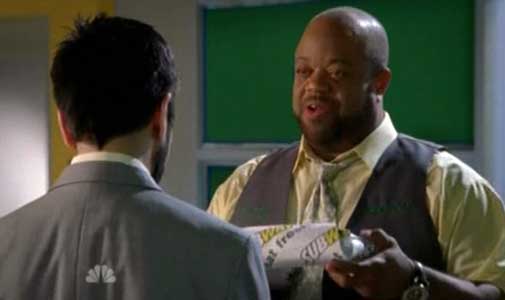
In one scene, the boss at Buy More, the stereo and appliance store seen on Chuck, offers an employee a reward for services rendered. The reward? A Subway sandwich, wrapped and ready.
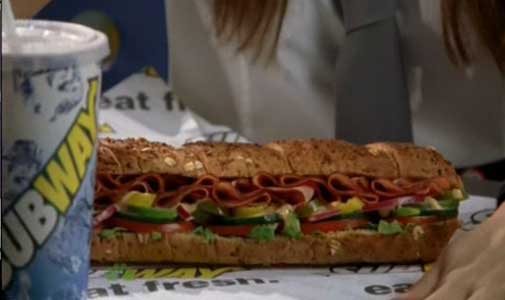
In another episode, starring guest star Summer Glau (now of NBC's The Cape), she plays a spy assassin going undercover as a Buy More employee. On her lunch break, she unwraps and spreads out her meal, shot in loving close-up -- down to and including the soft drink in the Subway cup, its label turned towards the camera just so.

And that's only the start of it. Next she takes out a fierce-looking switchblade and...
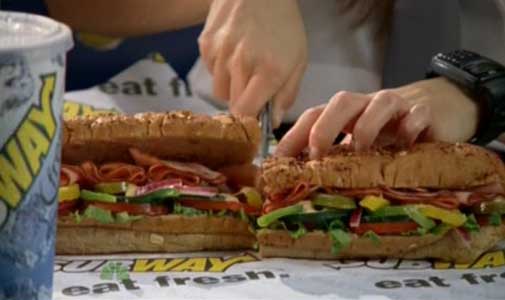
Cuts the sub in half. Which means lots more screen time -- but it's not Summer time. It's more time for the sub.

Finally, two other Buy More employees, staring at her through the door window of the break room, are heard voicing their suspicions that the woman is a spy. Not because she wields a switchblade at work, but because of the exotic meats and garnishes she selected for her made-to-order sandwich. "No Buy More employee," one tells the other, "is that sophisticated."
And no NBC viewer is that stupid. Although, considering the level of most NBC programming these days, that may be wishful thinking.
When TV began in the late 1940s and early 1950s, it was such a novelty that viewers didn't object to the model of radio sponsorship being transferred to television. Sponsors financed and controlled entire programs, which usually featured their corporate names right in the titles. Kraft Television Theatre. Camel News Caravan. Texaco Star Theater.
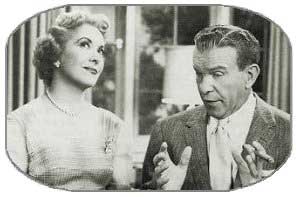
And even when the titles didn't include the sponsor's name or product, there was no mistaking who sponsored which program. Maxwell House coffee was served at every meal on Mama. Carnation Evaporated Milk soaked up so much air time on The George Burns and Gracie Allen Show, CBS threatened to pull the show unless the in-show ads were cut back.
Eventually, sole sponsorship ended and magazine-style spot advertising -- still the general current model -- began.
For about half a century, that's been good enough for broadcast TV. But now, as audiences dwindle along with their attention spans, other, more drastic moves are being put into play.
American Idol is only the start. Just as network IDs -- those ubiquitous lower-right-corner graphics called "bugs" -- have spread their way to apathetic acceptance, and similar graphics now promote other shows coming up on the network, lower-third ads are bound to grow, in use if not in popularity.
Similarly, over on NBC, Chuck is featuring admiringly photographed on-air sandwiches -- food porn -- to explode the current model of what constitutes a successful TV ad. It's product placement as media metaphor: a sub that aims to torpedo the TV status quo.
Commercials interrupting, rather than overlapping, programs? Ah, it seems, those were the good old days.